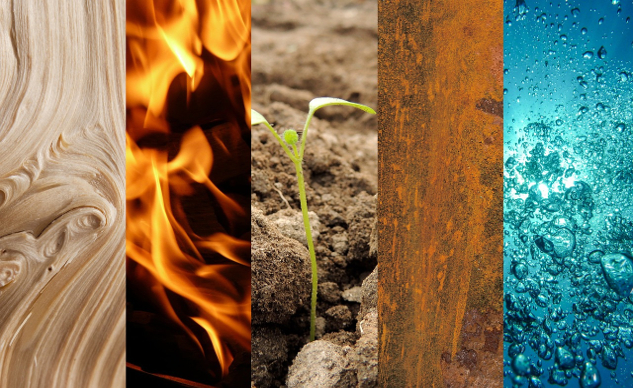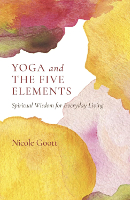
Image by Stefan Schweihofer
The five elements of earth, water, fire, air, and space are easily recognizable as forces existing around us all the time. The five elements exist not only around us in the Natural world but also within us, in both physical and metaphysical terms. The elements are unique properties of matter which manifest as modes of consciousness and provide a structure for sense perception.
If we think of a soul as consciousness without material or physical form, a vehicle is needed to facilitate communication in physical reality. One way, therefore, to think about the elements is the facilitation they provide of converting symbolic information into actionable information, advancing our learning and growth and the evolution of the soul.
Understanding Ourselves
The subtle bodies and the five elements are a framework that can help enlarge our understanding of ourselves. It can broaden our understanding of the relationships to each other, to Nature, and ultimately, the Source itself.
One way to work within the framework involves locating areas of stagnation, blockages, or a lack of flow. As new insights, perspectives, and understanding become available, feelings of increased vitality and satisfaction may reflect the dissolving of the obstruction. This satisfaction further indicates that not only is more life force is available, it is also flowing unobstructed. The greater the flow of life force and vitality, the closer we move toward the experiences of inner joy and peace.
The Elements and their Governing Principles
Each element has a governing principle(s) and corresponds with the function of a subtle body:
-
Earth is the element of physical embodiment and well-being. It corresponds with the physical body and Etheric subtle body whose function is vitality and life force.
-
Water is the element of easeful flow. It corresponds with the Astral body whose function is emotions.
-
Air is the element of higher perspective. It corresponds with the Mental body whose function is beliefs.
-
Fire is the element of illumination and transformation. It corresponds with the Casual body whose function is life purpose.
-
Space is the element of integration and union. It corresponds with the Buddhic body whose function is unity consciousness.
Together with the wisdom of the five elements and the orientation of the subtle bodies, we can examine questions such as:
-
What is the nature of our reality?
-
What does it mean to be human?
-
How do we each live with greater joy, fulfillment, and peace?
Inner States of Consciousness
Inner joy and peace are states of consciousness that we have access to daily. Working with the elements can be viewed as a form of spiritual practice. It has daily application without opposition to other traditions that may already form part of an existing spiritual belief system. Spiritual practice at its heart is the path that brings an individual closer to their own soul and closer to the Source of All Being.
Human beings by nature seek meaning in all that they experience. There is a shared fundamental curiosity, a desire to learn, to understand, and to know. Whilst the views may vary, all traditions and religions share an underlying structure that provides a view around which individuals may orient themselves for a sense of direction.
The challenge with any practice and life itself is to strike the balance of discovering and living from the middle way. This means that we are always being called back to a state of being that is operating in the center, rather than from an extreme on one side or another. We see this fundamental principle working all around us when we look to Nature which maintains a delicate balance across the entire planet while constantly moving.
Every individual is a composition and balance of the elements. The first relationship we identify is which element expresses itself within us most prominently. The more prominently expressed element is the one that principally shapes the way we create our own reality, the one we usually draw upon first. Although it's the element that may be the 'easiest' to work with, it can and does go out of balance. The function of ranking the elements in order from most easy to most difficult serves to understand better our blindspots. It also highlights areas that are of a greater or lesser challenge. It's then possible to create balance and experience integration.
Relationships and the Interaction of the Elements
Relationship dynamics are formulated and affected by the interaction of the elements as expressed in each person. Therefore, a useful tool in navigating the ups and downs of relationships is understanding the interaction of the elements in each individual. For instance, communication styles will vary in a person operating from the element of fire versus earth. Fire might be loud, excitable, or harsh. On the other hand, earth might be steady, even-toned, or stubborn.
The elements are always striving for balance and harmony. Too much or too little of one or more elements is a form of imbalance. It is also important to keep in mind that balance and harmony are not static states. The universe is constantly emerging into form, being sustained and maintained for a period of time, and then eventually dissolving out of form, returning once again to the formless state.
There is a quiescent restfulness between the period of form having dissolved and before form emerges. The element of space is the element into and out of which all other elements emerge and return.
The elements work together in a constant state of creating, maintaining, and returning to balance. As we welcome the elements, we invite their wisdom and teaching to illuminate our hearts and minds, that we may each live in greater harmony and unity. You know you’re in balance and on the right path when there is satisfaction, fulfillment, and an increased flow of life force. The ultimate goal of balance is working toward inner and outer harmony. Harmony is the doorway to inner and outer peace.
Copyright 2024. All Rights Reserved.
Book by this Author:
BOOK: Yoga and the Five Elements
Yoga and the Five Elements: Spiritual Wisdom for Everyday Living
by Nicole Goott.
 Who am I? What is my purpose in life? These are timeless questions. Indian philosophy and the yoga tradition offer a comprehensive understanding of the human being, from its conception of the mind to the nature of the soul, a path of self-discovery and doorway to inner liberation. With a fresh and modern interpretation of the five elements -- earth, water, air, fire, and space -- readers are presented with a practical and accessible approach to knowing themselves more deeply, illuminating how we might see other people with more compassion, tolerance, and acceptance.
Who am I? What is my purpose in life? These are timeless questions. Indian philosophy and the yoga tradition offer a comprehensive understanding of the human being, from its conception of the mind to the nature of the soul, a path of self-discovery and doorway to inner liberation. With a fresh and modern interpretation of the five elements -- earth, water, air, fire, and space -- readers are presented with a practical and accessible approach to knowing themselves more deeply, illuminating how we might see other people with more compassion, tolerance, and acceptance.
With a framework that integrates the physical body with the inner terrain of the subtle bodies, Yoga and the Five Elements is an ideal guide for yoga practitioners and teachers to explore a modern interpretation of ancient wisdom. For contemporary spiritual seekers and individuals with no background or experience with yoga, Yoga and the Five Elements offers an imminently practical approach to self-development.
For more info and/or to order this book, click here. Also available as a Kindle edition.
About the Author
 Nicole (Nicci) Goott is a passionate and dedicated teacher, motivated to guide others in their journey of self-discovery and how to live a joy-filled life. Born and raised in Johannesburg, South Africa, Nicole moved to the United States when she was twenty-four years old, following an inner call to discover her dharma. Her teaching, mentoring, and healing approach reflects a fusion and synthesis of more than two decades of study in Yoga, Ayurveda, and related healing arts practices, as well as mindfulness-based approaches to self-healing.
Nicole (Nicci) Goott is a passionate and dedicated teacher, motivated to guide others in their journey of self-discovery and how to live a joy-filled life. Born and raised in Johannesburg, South Africa, Nicole moved to the United States when she was twenty-four years old, following an inner call to discover her dharma. Her teaching, mentoring, and healing approach reflects a fusion and synthesis of more than two decades of study in Yoga, Ayurveda, and related healing arts practices, as well as mindfulness-based approaches to self-healing.
For more information, visit NicoleGoott.com/

























